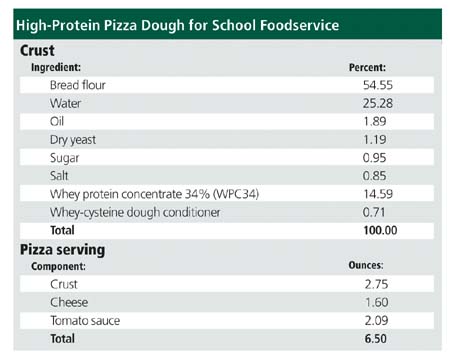
A: Protein-rich dairy ingredients are well poised to replace meat as APP in school foodservice. This role presents exciting formulation opportunities for dairy processors and food manufacturers.
Such APP must meet three USDA criteria for use in school foodservice. They must be processed to remove some of their non-protein constituents. They must have a measure of protein quality as determined by a protein digestibility corrected amino acid score (PDCAAS), which is at least 80% that of casein. And they must contain at least 18% protein by weight when fully hydrated or formulated.
Many dairy processors and food manufacturers are just now completing documentation for USDA to allow them to use nonfat dry milk (NDM), whey protein concentrate (WPC), whey protein isolate (WPI) and cheese powders as protein sources in school foodservice casseroles, pizzas, entrées and more. For example, one major manufacturer is exploring how cheese powders may be used to formulate school foodservice products such as cheese sauce and macaroni and cheese. Manufacturers using APP must document the amount of protein and provide instructions for use.
Cold Fusion Foods, Culver City, Calif., is already using WPI in Cold Fusion Cups and Power Pops that are featured in several school districts. These protein-packed frozen novelties are popular not only for lunch, but also as a la carte items, after-school snacks and in vending machines.
Not only may APP be used in manufactured foods for schools, they may be used as ingredients in dishes prepared onsite. The Midwest Dairy Assn., St. Paul, Minn., recently did an informal survey of regional school foodservice operators about their use of dairy ingredients. Operators said they felt comfortable using NDM as an ingredient in foods prepared onsite. Indeed, NDM made sense in baked goods where they felt it added nutrition benefits.

The survey also revealed that most foodservice operators do not have hands-on experience using other dairy ingredients that qualify as APP. These ingredients are most likely to be formulated into recombined foods, such as WPC34, which is often used in pizza crust, or WPC80, which can be found in reduced-fat hot dogs.
Typical foods found in school foodservice also represent new formulation possibilities for food manufacturers. For instance, today's school lunches include many kinds of finger foods, such as chicken nuggets and fish sticks, which could be breaded with a mixture that includes dry milk and whey ingredients. Meat loaf, meatballs, sauces and gravies can also take advantage of dry milk and whey ingredients. Nonfat dry milk can be used in yogurt.
To view the rules, visit www.fns.usda.gov/cnd/care/regs-policy/policy.htm. For technical expertise and production assistance in formulations for school foodservice, contact the DMI Technical Support Hotline at 800/248-8829 or email technicalsupport@doitwithdairy.com.